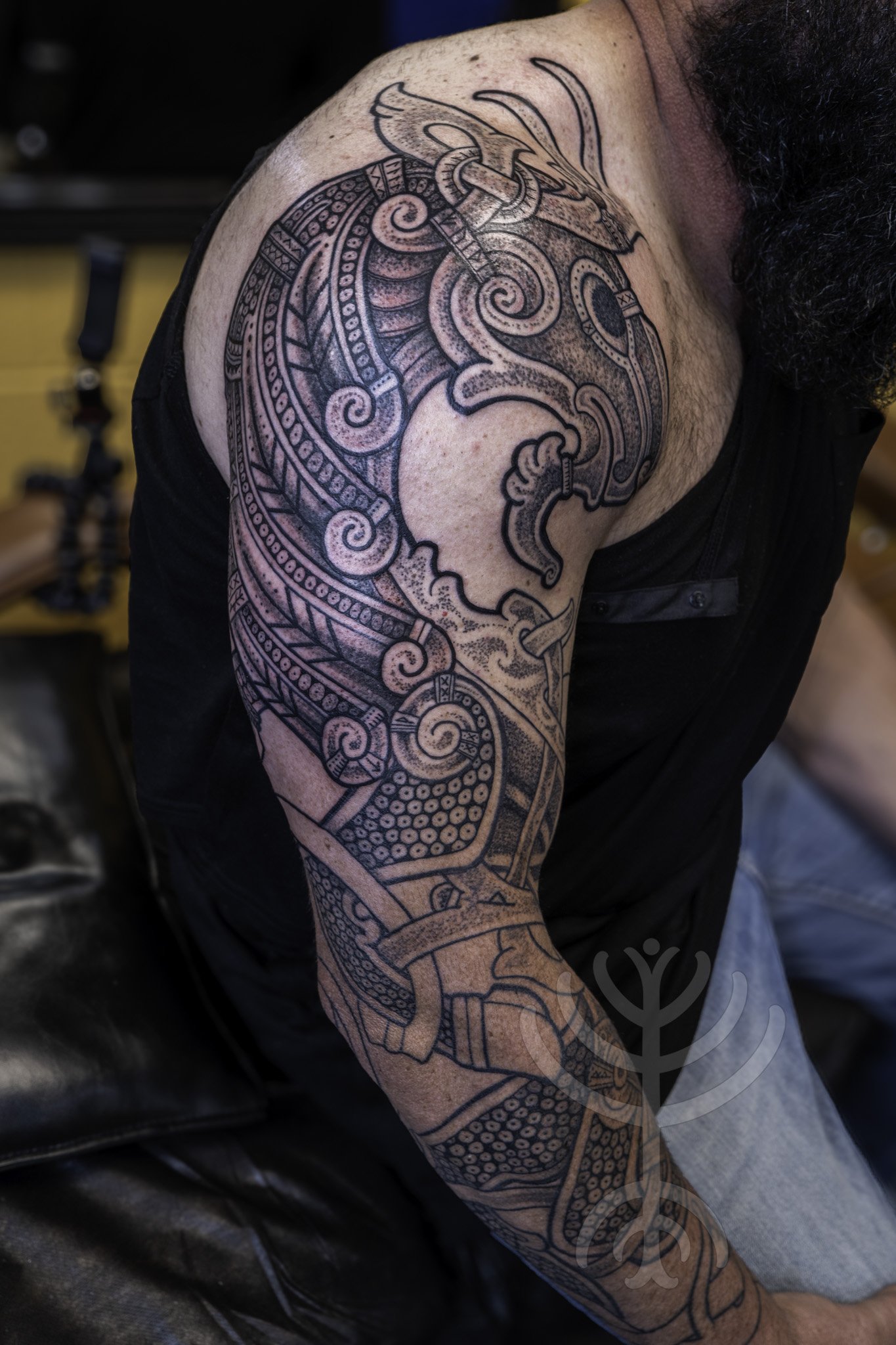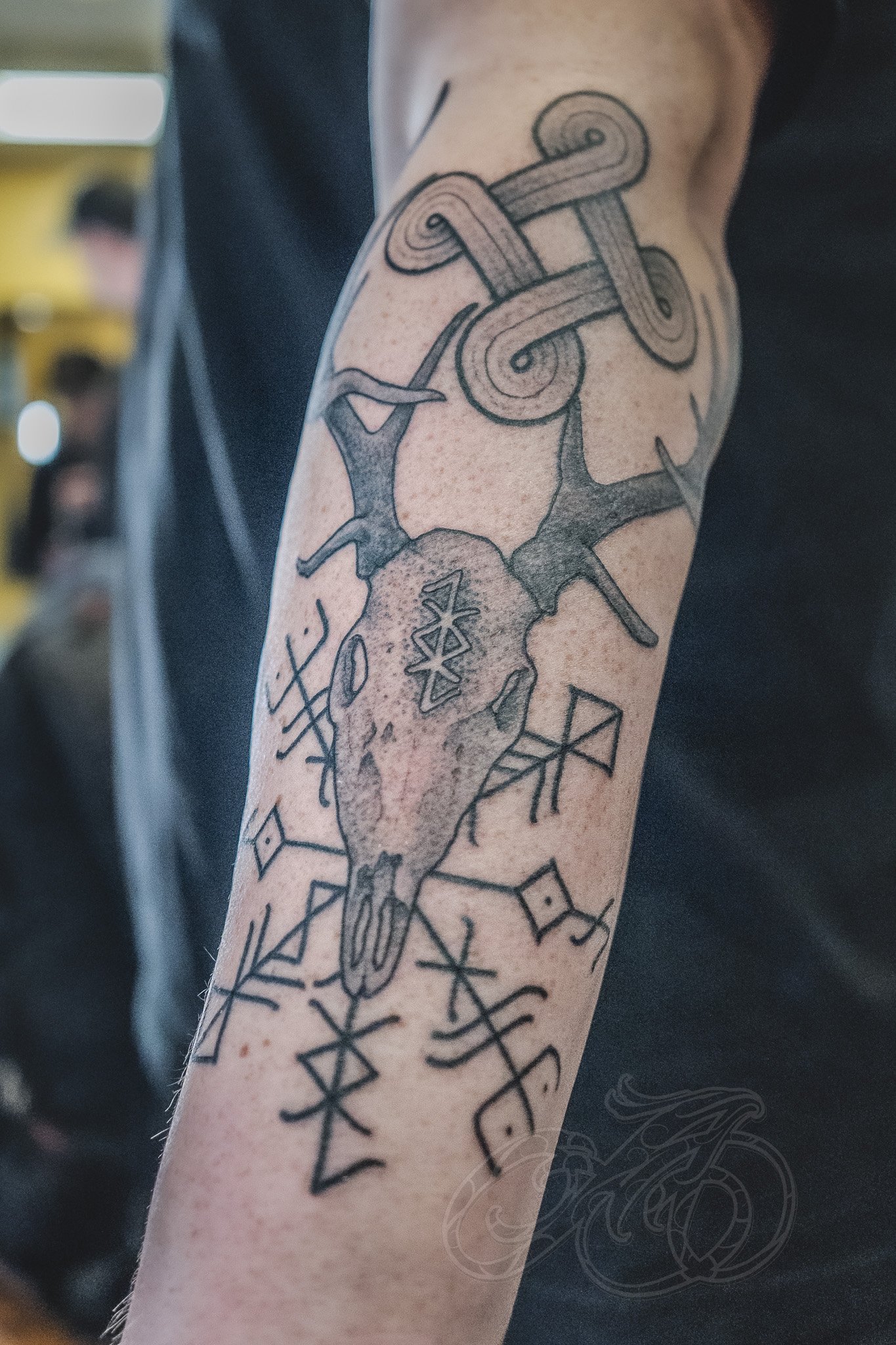Nordic tattoos to avoid and the best ones to get instead
Nordic tattoos carry sacred meanings. Symbols like the Valknut, Helm of Awe, and runes can be powerful, but also misunderstood or misappropriated. Some designs are tied to hate groups, while others lose meaning when used without cultural context.
To avoid unintentional offense or regret, it’s important to know what these tattoos represent, and what they don’t. Especially for first-timers or anyone exploring Norse/Nordic mythology for the first time, research and intent matters as much as the design.
As featured in Nordic Tattoos Vol. 3 and the upcoming Northern Black Nordic site, I’ve had the privilege of contributing to the global conversation around Nordic and Viking symbolism. My work bridges historical authenticity with modern artistry, helping clients choose designs that honor tradition while avoiding missteps.
Want to know which Nordic symbols to avoid, and which to honor? Here’s what you need to know before getting inked.
What Are Nordic Tattoos?
Nordic tattoos draw from Norse mythology, Viking-age symbolism, and ancient runic alphabets like the Elder Futhark. These designs include sacred symbols like Vegvisir (the runic compass), Valknut (often linked with Odin), Mjölnir (Thor’s hammer), Yggdrasil (the world tree), and various bindrunes (fused runes with layered meanings).
These motifs are popular not only for their bold, geometric beauty but also for their deep cultural and spiritual roots. They represent themes like protection, fate, strength, and guidance.
However, it’s important to understand the difference between historical context and modern usage. Many Norse symbols have been misinterpreted, commercialized, or repurposed by hate groups, making it critical to approach them with knowledge and respect. What was once a spiritual emblem might now carry unintended connotations, especially when taken out of cultural context.
Before choosing one of these tattoos, know what it means, then work with an artist who honors that meaning.
Nordic Symbols You Should Avoid
While Norse tattoos are visually striking and rich in heritage, not every symbol is safe, or respectful, to wear. Some motifs are misunderstood, misused, or carry dangerous modern associations.
Odal Rune & Wolfsangel: Once used in ancient runic alphabets, these symbols have been co-opted by white supremacist groups and neo-Nazis. Wearing them can send unintended messages or get misinterpreted, especially in Western countries.
Incorrect or Mixed Runes: Mismatched or misused runes (often pulled from Pinterest or AI generators) may result in tattoos that say nothing, or worse, something offensive. Runes have phonetic and symbolic meanings; they’re not just aesthetic.
Valknut: Often romanticized as a “warrior mark,” this symbol is more accurately associated with death, sacrifice, and Odin’s power over fallen souls. It’s sacred, not decorative.
Helm of Awe (Ægishjálmr): Frequently stylized incorrectly or stripped of spiritual context. This protective symbol requires cultural understanding, not just visual appeal.
Horned Helmets & Viking Caricatures: No, Vikings didn’t wear horned helmets. These clichés are historically inaccurate and reduce Norse culture to pop-culture fantasy.
Marvel-Style Loki & Odin Tattoos: While fandom tattoos are valid, using comic depictions of Norse gods without regard for their spiritual roots can feel disrespectful to those who honor these traditions.
How Nordic Tattoo Choices Differ by Client Type
Every tattoo journey is personal, but when it comes to Nordic imagery, the stakes are higher. Whether you’re new to ink or planning a detailed sleeve, knowing how your tattoo goals intersect with cultural symbolism is key.
First-Timers: Pinterest boards are a common starting point, but many contain incorrect or controversial designs, especially bindrunes or Helm of Awe variants. New clients often need help verifying meaning and placement to avoid lifelong regrets.
Tattoo Enthusiasts: When building full sleeves or combining multiple Norse symbols, enthusiasts may unintentionally blend historical and fictional elements (like mixing Odin’s ravens with Marvel’s Loki). A skilled artist can help maintain authenticity and coherence.
Sentimental Seekers: Choosing Nordic symbols for tribute tattoos, like Yggdrasil for family roots or Valknut for a lost loved one, can be emotionally powerful. But these symbols carry heavy cultural weight, and context is everything. Always confirm the historical meaning.
Aesthetic-Focused Clients: Minimalist knotwork or runes may look stylish, but some variations resemble hate-group emblems or misused iconography. If the look is your priority, a knowledgeable artist can guide you toward safer, beautiful alternatives.
Cover-Up Clients: Many people seek cover-ups after learning their original Nordic tattoo has offensive ties or was poorly translated. Success lies in balancing strong visual motifs with thoughtful cultural awareness.
What’s Considered Cultural Misuse (vs. Cultural Appreciation)?
Getting a Nordic tattoo isn’t inherently wrong, but intention and knowledge matter. These symbols aren’t just aesthetic, they carry deep historical, religious, and emotional weight for many.
Cultural Misuse: Happens when someone chooses a rune or symbol based solely on appearance, without understanding its origins, meanings, or spiritual context. This includes:
Random bindrunes copied from Pinterest.
Using sacred motifs (like Valknut or Helm of Awe) without understanding their connections to death, protection, or ritual.
Trivializing gods like Odin or Thor through pop-culture versions.
Cultural Appreciation: Starts with research and respect. If a symbol resonates with you, take time to learn its mythological backstory and modern spiritual significance. When done thoughtfully, Norse tattoos can be a powerful way to honor heritage or embody personal values.
How to Check If a Rune or Symbol Is Problematic
With Nordic tattoos, the line between powerful and problematic can be surprisingly thin. Here's how to avoid embarrassment or worse when selecting runes or symbols.
Check Hate Group Databases: Start with the Anti-Defamation League Hate Symbol Database or similar watchdog sites. Symbols like the Odal Rune, Wolfsangel, or the Black Sun have been co-opted by white supremacist groups. Even if your intent is pure, others may see hate.
Know Your Runes: There’s more than one rune system, Elder Futhark, Younger Futhark, and Anglo-Saxon variants differ significantly. Mixing them can lead to nonsense translations or confusing meanings.
Research Symbol Histories: Some motifs, like the SS-style runes or Sunwheel variants, carry direct Nazi associations.These designs may be illegal in parts of Europe or result in major social backlash.
Consult Cultural Tattoo Specialists: Artists who have experience with Norse or pagan iconography can help you avoid design faux pas.
Skip the Pinterest Trap: Flashy posts may lack substance. Always trace imagery back to primary sources, like scholarly articles, Old Norse texts, or expert translations, before putting it on your skin.
Mistakes (and How to Avoid Them)
Even with good intentions, many people make missteps when choosing Nordic-inspired tattoos. Here’s how to steer clear of the most frequent (and avoidable) errors.
Using Google Translate for Norse Language: Old Norse doesn’t translate cleanly into modern English. Using tools like Google Translate often leads to nonsensical or fake translations. Runes require context and proper syntax, skip auto-translators and consult experts instead.
Mixing Celtic and Nordic Styles: While both traditions use knotwork and symbolism, they stem from different cultures. Combining them without thought can look aesthetic but historically inaccurate, diminishing meaning for both.
Over-designing with Too Many Disconnected Elements: A Vegvisir, Yggdrasil, Valknut, and bindrune all in one piece? It’s tempting, but cluttered designs blur meaning. Each symbol has weight, stacking them can confuse the message or dilute spiritual intent.
Relying on Flash Sheets or Fantasy Art for Sacred Symbols: Many flash designs, especially online or in non-specialized shops, distort sacred symbols. Fantasy-style Odin or Thor tattoos may look cool but strip away the cultural or mythological truth behind them.
Safer Alternatives for Viking-Inspired Ink
You can honor Norse heritage without crossing cultural or ethical lines. Here are tattoo design ideas that stay respectful, visually striking, and full of personal meaning:
Knotwork Animals from Norse Art: Inspired by ancient wood carvings and Viking artifacts, animals like wolves, ravens, and dragons in knotwork styles reflect strength, guardianship, and lore, without invoking modern misappropriations.
Stylized Yggdrasil (with Context): The tree of life can be adapted in symbolic or minimalist forms. Just be sure to understand its mythological depth, Yggdrasil represents the cosmos, not just “life” or “growth.”
Mythical Beasts like Fenrir or Jörmungandr: These characters from Norse mythology embody chaos, prophecy, or transformation. When used in story-driven designs, they carry strong visual impact without leaning on problematic symbols.
Norse-Inspired Blackwork or Dotwork: Using Norse visual themes (like symmetry, weapon shapes, or ships) in modern blackwork or dotwork styles offers clean, aesthetic tattoos rooted in tone, not specific sacred symbols.
Personal Bindrunes (With a Trained Artist): A custom bindrune crafted with care and meaning can be deeply personal and culturally aware. Work with an artist who understands rune construction, not just aesthetics.
These styles let you celebrate Nordic themes while avoiding missteps. With thoughtful collaboration, you can get a tattoo that feels meaningful and looks incredible, without cultural harm.
Why Work With Aloha Tattoos
When it comes to Nordic or culturally rooted tattoos, research, accuracy, and artistic respect are everything. That’s where Aloha Tattoos stands out.
The Aloha Advantage
Artists trained in cultural tattoo accuracy: Some of our artists are educated in the historical, mythological, and ethical dimensions of sacred symbols, not just the design.
Collaborative design sessions with historical awareness: Your ideas aren’t just drawn, they’re explored. We will ask the right questions to ensure your tattoo reflects truth, not stereotypes.
Eco-conscious, inclusive studio culture: From plant-based supplies to cultural sensitivity, we offer a safe, modern space for everyone, especially those honoring ancestral or spiritual art.
Custom bindrunes crafted with meaning: These aren’t random combinations pulled off Pinterest. We create bindrunes only after discussing your values, background, and intentions.
Why Cheaper or DIY Isn’t Worth It
No research = offensive or harmful ink: One wrong symbol can send the wrong message or associate you with hate groups.
Bad technique = poor healing and distortion: Cultural tattoos demand precision, DIY or budget shops often lack that.
No guidance = regret: Without an artist who understands symbolism, you risk getting something you don’t truly believe in, or understand.
At Aloha Tattoos, every line has a reason, and every symbol is earned
Final Takeaways Before You Book
Before you commit to any Nordic or Viking-inspired tattoo, take a moment to check your meaning, and your artist.
Ask about origin and symbolism: Your tattoo should reflect more than visuals. A reputable artist will know the story behind the symbol, and be honest if it’s problematic.
Don’t rush sacred designs: Helmets, bindrunes, and Norse gods carry centuries of history. Make sure you're honoring, not appropriating.
Bring high-res references, but stay open: A great artist will guide you on what works best for your skin, placement, and intent.
Work with artists who care about culture :We prioritize ethics, education, and personalization, so you leave with work you’re proud of, not second-guessing.
Ready to get inked with meaning? Book a consultation with Aloha Tattoos today.



